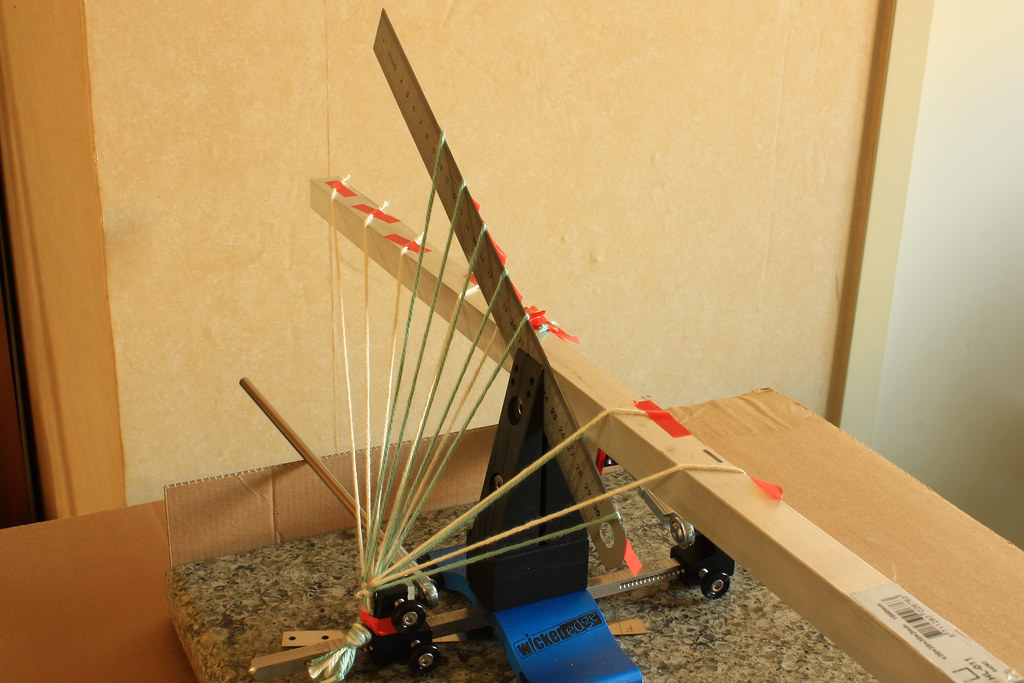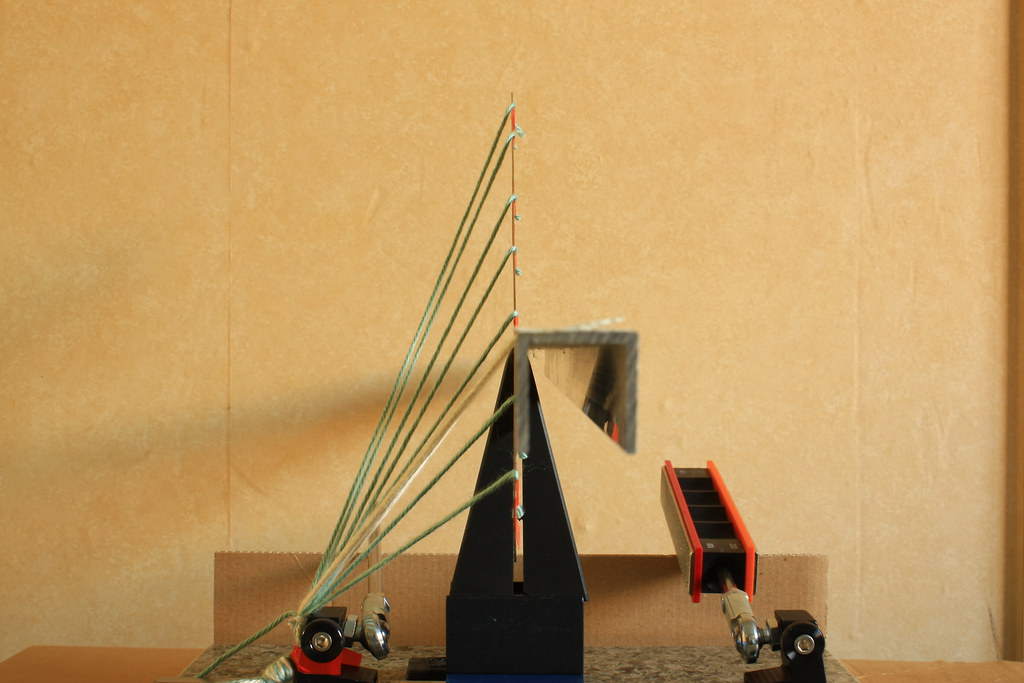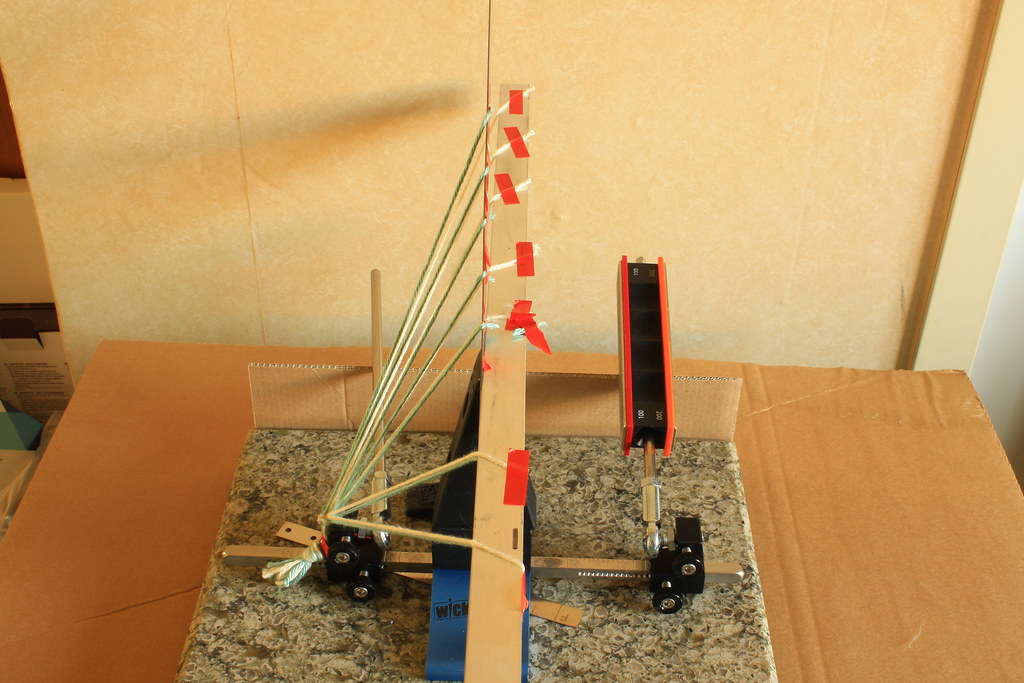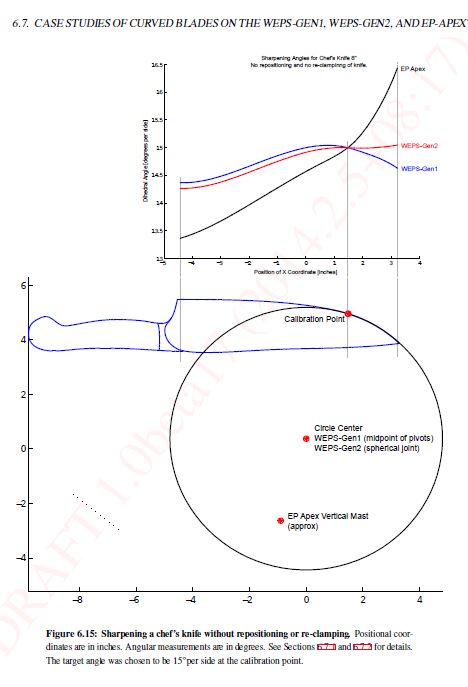Advanced alignment guide
Recent › Forums › Main Forum › Product Announcements › Advanced alignment guide
- This topic has 189 replies, 22 voices, and was last updated 05/24/2016 at 3:13 am by
 M1rrorEdge.
M1rrorEdge.
-
AuthorPosts
-
02/18/2016 at 6:05 pm #31388
Hey Frans, thanks for the input and doing that. Can you do me a favor and on the angled knife, site down the straight portion or the edge, and see if things line up or not? Like I showed with the floss, I think that’s the actual sharpening angle.
02/18/2016 at 6:48 pm #31389I went ahead and duplicated what Frans did, but on the WE, and just like before, if you site down the edge, it becomes one angle…
…so unless this isn’t what the edge is sharpened at, then… ?
(Sorry I couldn’t get a focus on the ruler in the straight down shot).
Attachments:
You must be logged in to access attached files.
02/18/2016 at 6:59 pm #31391Hi Curtis,
It is almost 3AM here in the Netherlands so just a quick reply for now.
Am I correct that for your second picture, you rotated the whole system, the ruler as well as the clamp?
If so, I think that the point would be that all things should be equal to a normal set-up with the only exception of the tilted ruler.You said “the way I see it, the pivot, which travels in a circle, has no “idea” what the orientation of the clamp is”
I would say that the pivot has no idea of the orientation of the clamp but it will have an idea of the position of the knife.
02/18/2016 at 7:06 pm #31392Sorry, didn’t know what time it was.
If I understand your question, for the picture I just took? I didn’t rotate anything, the side view shows the setup, then I just moved the camera and took a shot looking down the edge… (like I did with the old floss picture).
You said “the way I see it, the pivot, which travels in a circle, has no “idea” what the orientation of the clamp is” I would say that the pivot has no idea of the orientation of the clamp but it will have an idea of the position of the knife.
I kinda understand this… although if it doesn’t know the orientation of the clamp, then no matter what angle you set the knife at, you can rotate the clamp until the knife is “level”, if that makes sense.
02/19/2016 at 7:52 am #31403Okay, a new day and I took some new photos with both a level aluminum bar and an angled ruler positioned in the clamp. I attached yellow threads to the aluminum bar and green threads to the ruler.

Changing the camera position so the lens looks straight down the aluminum bar, all the yellow threads line up.

Lowering the camera and tilting it up so it looks straight up the angled ruler, all the green threads line up.

Raising the camera and tilting it down, the green and the yellow threads line up.

So, although counter-intuitive, I think you are right and it is all a matter of perspective.
Frans
I
02/19/2016 at 8:31 am #31404Wow. Thank you very much for that… that’s an awesome setup. You’re right, very counter intuitive.
I find that third picture intriguing… how everything lines up. I think there’s a hidden meaning in there… just not sure what it is.
Thanks again!
02/19/2016 at 8:55 am #31405I find that third picture intriguing… how everything lines up. I think there’s a hidden meaning in there… just not sure what it is. Thanks again!
I am not sure either but maybe this….
Looking at the pictures of the yellow threads lining up on the aluminum bar and the green threads on the ruler, I still wondered if both would be sharpened at the same angle. My thinking was that as long as your viewpoint is in line with a certain angle, it will always line up if that angle is constant.
Looking at the last picture, I think it merges the two viewpoints, showing that the angle is the same for both of them.
Hope that makes sense
02/19/2016 at 9:31 am #31407I find that third picture intriguing… how everything lines up. I think there’s a hidden meaning in there… just not sure what it is. Thanks again!
I am not sure either but maybe this…. Looking at the pictures of the yellow threads lining up on the aluminum bar and the green threads on the ruler, I still wondered if both would be sharpened at the same angle. My thinking was that as long as your viewpoint is in line with a certain angle, it will always line up if that angle is constant. Looking at the last picture, I think it merges the two viewpoints, showing that the angle is the same for both of them. Hope that makes sense

Makes sense. I tried measuring some angles yesterday, but when things aren’t level, the angle cube can provide a variety of readings… to the point I could make it read whatever I wanted it to… so it skews the result.
If I get around to setting up a way to post video, I did a test some might find interesting…

Attachments:
You must be logged in to access attached files.
02/19/2016 at 10:07 am #31411Nice setup and it verifies that the same angle will be sharpened into a perfectly straight edge no matter what the inclination and length is.
I was trying to verify this with my cheesy video setup against parallel lines. I messed it up because the camera was not mounted to the rod/stone so that it “travels along the edge”. I am still thinking on how to accomplish that (GoPro, … ). The other video (from Yan’s paper) is the animated mathematical model of the chef knife which I am calling the Gold Baseline. Do you agree ? The Gold Baseline is run in Matlab but is NOT setup to allow for different knives or inclinations.
I am trying to replicate some version of the Gold Baseline in a setup which would allow different knives and inclinations. The goal is to be able to determine (and verify) the best setup for minimal angle deviation along the entire knife (99% of knives are NOT straight but are made up of straight segments).
People of course ask “why bother”. Well, it is probably the biggest downside to guided rod sharpening systems. The upsides greatly outweigh it but it is still a downside. We know that Clay’s Advanced Alignment Guide (AAG) will help/solve the “sharpening the next time setup”, but I am interested in the first time optimal position. I have 20+ kitchen knives @ $200 per as a lifetime investment. When they are sharpened by Shun or whomever on “non guided rod systems” I can get 15 DPS +- __ deg along the entire edge. The question is: “what is the +- __ deg”. Verification measurement of actual sharpened angles along an entire knife edge is both intriguing and non-trivial. It piques my engineering curiosity. Elegant solutions are sometimes found (like turning a bubble 180 deg to help remove biases).
Right now we cannot get correlated measurement results (even with the Laser Ganiometer). More to come but it takes time.
1 user thanked author for this post.
02/19/2016 at 11:57 am #31413Well, you both have convinced me that I was wrong; that an inclined edge will have a constant angle, as long as the edge is a straight line. This confirms Clay’s initial observation of a constant angle along the relatively straight edge of his chef’s knife. I humbly concur with your findings. I have been viewing the angle with respect to the blade’s vertical centerline. Your view of it with respect to the blade’s edge was an eye-opener.
02/19/2016 at 12:39 pm #31415Nice setup and it verifies that the same angle will be sharpened into a perfectly straight edge no matter what the inclination and length is. I was trying to verify this with my cheesy video setup against parallel lines. I messed it up because the camera was not mounted to the rod/stone so that it “travels along the edge”. I am still thinking on how to accomplish that (GoPro, … ). The other video (from Yan’s paper) is the animated mathematical model of the chef knife which I am calling the Gold Baseline. Do you agree ? The Gold Baseline is run in Matlab but is NOT setup to allow for different knives or inclinations. I am trying to replicate some version of the Gold Baseline in a setup which would allow different knives and inclinations. The goal is to be able to determine (and verify) the best setup for minimal angle deviation along the entire knife (99% of knives are NOT straight but are made up of straight segments). People of course ask “why bother”. Well, it is probably the biggest downside to guided rod sharpening systems. The upsides greatly outweigh it but it is still a downside. We know that Clay’s Advanced Alignment Guide (AAG) will help/solve the “sharpening the next time setup”, but I am interested in the first time optimal position. I have 20+ kitchen knives @ $200 per as a lifetime investment. When they are sharpened by Shun or whomever on “non guided rod systems” I can get 15 DPS +- __ deg along the entire edge. The question is: “what is the +- __ deg”. Verification measurement of actual sharpened angles along an entire knife edge is both intriguing and non-trivial. It piques my engineering curiosity. Elegant solutions are sometimes found (like turning a bubble 180 deg to help remove biases). Right now we cannot get correlated measurement results (even with the Laser Ganiometer). More to come but it takes time.
I think your test helped, even if it didn’t come out like you hoped.
i hope you come up with something… I know “why bother”.
1 user thanked author for this post.
02/19/2016 at 12:48 pm #31416This may take a couple of tries to post, but here’s the quick video I mentioned. I tried to show at the start how the stone “locks in” to the angle (you’ll hear it ‘click’), then stays the same, even if the edge is “vertical”.
1 user thanked author for this post.
02/19/2016 at 2:30 pm #31421Great video. Nice to see how the arm moves in and out while the sharpening angle does not change.
02/20/2016 at 12:23 am #31439Hmm, I admit defeat. I have been unable to scheme up a reasonable optical method to verify the sharpened angle. There is just too much variation in my setup to visualize the real time relative angle changes over the length of a chefs knife. I will leave it to Yan’s Matlab model to demonstrate the “best” variation of 0.8 deg when mounted just before the start of the curve to the knife tip (assuming you can match the curve with the O-ring approach). I think the reality is more like 1-2 deg of variation when you put together the reality of various tolerance et al. It is very frustrating that we can’t measure because that is how you improve.
Please allow me to vent. I am a kitchen knife guy. I own no other knives. I’ve had my Gen 3 field model for 3 months and can put a shaving edge on all my knives. I take great pride in the slicing of all meats with my 12”, 10” and 8” slicers. The issue is that with my longest knives. Visually I see probably a 5 deg angle change from the heel to the tip.
So the question is: what is the best approach to sharpen long thin slicing knives which inherently flex. I’m guessing a multiple position changes are needed but how would I blend the positions. I also would like to have convex edge profiles. Slicing is an art which I am just getting decent at after 35 years. My tool is the knife and the edge is everything.
Attachments:
You must be logged in to access attached files.
02/20/2016 at 6:00 am #31444Hmm, I admit defeat. I have been unable to scheme up a reasonable optical method to verify the sharpened angle. There is just too much variation in my setup to visualize the real time relative angle changes over the length of a chefs knife.
A tough challenge, for sure.
Visually I see probably a 5 deg angle change from the heel to the tip.
It’s a straight edge? Given everything discussed the last few days, I don’t understand why you’re seeing this?
So the question is: what is the best approach to sharpen long thin slicing knives which inherently flex.
I’ve had success clamping the knife with the majority of it toward me, then just holding the handle against my body, or actually securing it with string. Others have designed clamps to hold longer knives, hopefully some will weigh in.

I also would like to have convex edge profiles.
Clay has a method where he sharpens the bevel in 1 or 2 degree increments, then blends the bevels with the leather strops. I’ve done convex knives by taping sandpaper to leather.
You should be able to do a forum search for “flexible” knives and “convex”, for previous discussions. (Maybe start a new thread if you have questions… this one has gotten looong haha).
-
AuthorPosts
- You must be logged in to reply to this topic.




